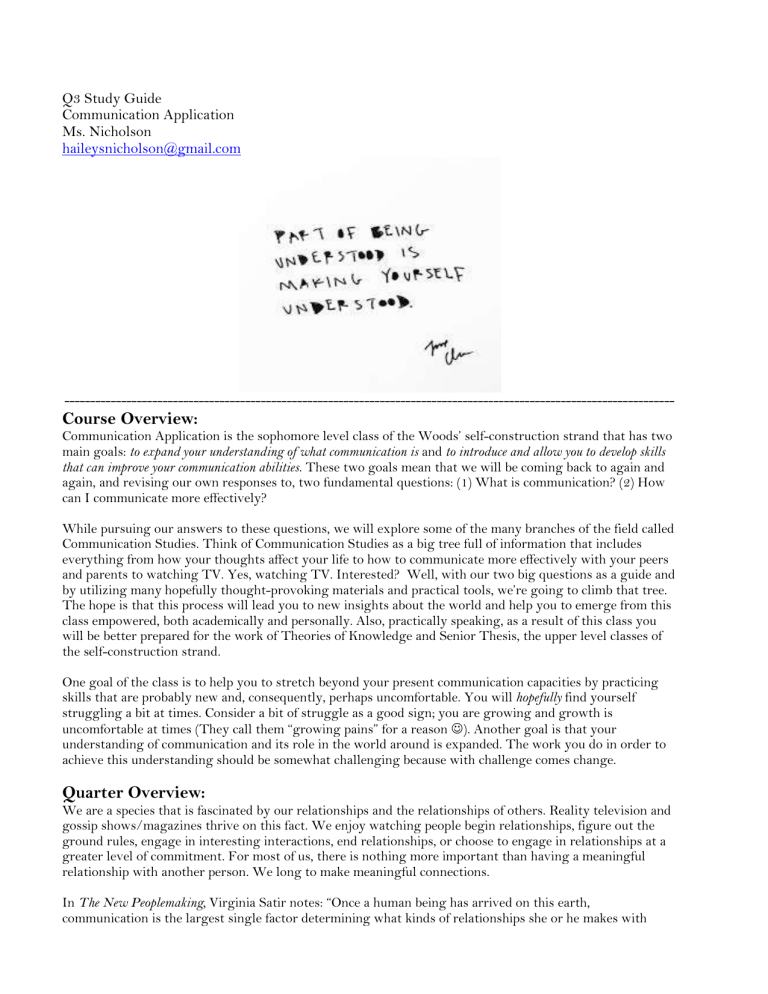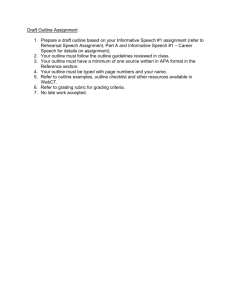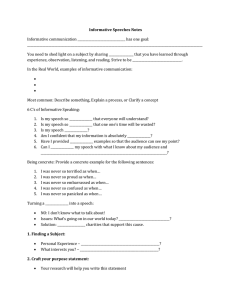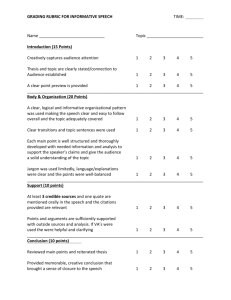
Q3 Study Guide Communication Application Ms. Nicholson haileysnicholson@gmail.com ---------------------------------------------------------------------------------------------------------------------- Course Overview: Communication Application is the sophomore level class of the Woods’ self-construction strand that has two main goals: to expand your understanding of what communication is and to introduce and allow you to develop skills that can improve your communication abilities. These two goals mean that we will be coming back to again and again, and revising our own responses to, two fundamental questions: (1) What is communication? (2) How can I communicate more effectively? While pursuing our answers to these questions, we will explore some of the many branches of the field called Communication Studies. Think of Communication Studies as a big tree full of information that includes everything from how your thoughts affect your life to how to communicate more effectively with your peers and parents to watching TV. Yes, watching TV. Interested? Well, with our two big questions as a guide and by utilizing many hopefully thought-provoking materials and practical tools, we’re going to climb that tree. The hope is that this process will lead you to new insights about the world and help you to emerge from this class empowered, both academically and personally. Also, practically speaking, as a result of this class you will be better prepared for the work of Theories of Knowledge and Senior Thesis, the upper level classes of the self-construction strand. One goal of the class is to help you to stretch beyond your present communication capacities by practicing skills that are probably new and, consequently, perhaps uncomfortable. You will hopefully find yourself struggling a bit at times. Consider a bit of struggle as a good sign; you are growing and growth is uncomfortable at times (They call them “growing pains” for a reason ). Another goal is that your understanding of communication and its role in the world around is expanded. The work you do in order to achieve this understanding should be somewhat challenging because with challenge comes change. Quarter Overview: We are a species that is fascinated by our relationships and the relationships of others. Reality television and gossip shows/magazines thrive on this fact. We enjoy watching people begin relationships, figure out the ground rules, engage in interesting interactions, end relationships, or choose to engage in relationships at a greater level of commitment. For most of us, there is nothing more important than having a meaningful relationship with another person. We long to make meaningful connections. In The New Peoplemaking, Virginia Satir notes: “Once a human being has arrived on this earth, communication is the largest single factor determining what kinds of relationships she or he makes with others and what happens to each [relationship] in the world. How we manage survival, how we develop intimacy, how productive we are, how we make sense…all depend on our communication skills.” Satir captures the perspective of this class: communication is at the root of everything! This quarter we will explore, what goes into making a relationship, where our own relationships and relationship skills stand, and how we can improve them. This in turn will, hopefully, lead to improved relationships for us all. In the second half of the quarter, we will learn about the tricky differences between an informative and a persuasive speech and the steps to create a formal informative speech. We will also continue adding to our toolkit some things that will help us to build and perform all speeches. The quarter will end with a final formal informative speech. --------------------------------------------------------------------------------------------------------------------- GQ1: How can I develop my interpersonal communication? Lessons: Interpersonal Communication and Relationships Effective Listening Skills In-Class Participation: Listening Exercises Aggressive, Passive, Assertive Conflicts Elevator Pitch Prep Completion Work 1. Relationships Visual 2. How Well Do You Know Me? Game 3. Parent Interview 4. Communication Practice 5. Love Languages 6. Reading Rubric Work: A. Elevator Pitch ---------------------------------------------------------------------------------------------------------------------Completion Work Explanations: 1. Relationships Visual Create a visual representation of your current “web” of relationships with you in the center. Include your immediate family and the other important people in your life. Represent how close you feel to a person by how close you place them next to you on the page, and write 13 words that describe how you generally feel when you are with them and/or represent it visually. (i.e. I might describe my relationship with my childhood friend as “stressful” and “stable” and/or draw a storm cloud.) Your choice to share. 2. How Well Do You Know Me? Game Choose a parent or caregiver that you would like to get to know better and see how many of the following questions you can answer correctly about one another. Choose a time when you both are relaxed and a place that you feel comfortable. Write a 200-word reflection on what the experience was like, including who you did it with. What is my favorite restaurant, and what would I order if we were there? What is my favorite app on my phone, and what does it do? What type of music do I listen to most often, and how do I access it? Who are some of the most important people in my world at the moment? What is my favorite outfit, and when am I most likely to wear it? If I could change one thing that happened this week, what would it be? Who do I consider my closest friend(s)? Has anyone dropped off or came on to that list recently? If I could be instantly qualified for any career, what would it be? 3. Parent Interview Record an interview with a parent or caregiver about what friendships have meant in his or her life (your choice of recording device.) Use a minimum of seven questions (ones from below or your own). This is should be a conversation rather than a back-and-forth question and answer session. Allow enough time so that you don’t feel rushed and can get curious about your parent or caregiver’s answers. Choose an excerpt for me and/or the class to listen to, and be prepared to share what stood out to you from the interview in general. Examples: Who was your best friend when you were my age? What was the funniest, scariest, etc. thing you did with them? What does friendship mean to you today? Has it changed from when you were my age? What does it mean for you to be a friend? Have you ever lost a friend? How have you been most supported by a friend? Have you ever been betrayed by a friend? 4. Communication Practice Choose a partner and with the Levels of Intimacy handout, practice communicating messages at different levels of intimacy, beginning with Level 1 and working up to Level 5. Choose any topic(s): sports, family, school, movies, etc. Aim for at least 20 minutes. Write a 200word reflection on what the experience was like, include the name of your partner. 5. Love Languages Background: The idea of “love languages” was theorized by Dr. Gary Chapman. “According to this theory, each person has one primary and one secondary love language. Chapman suggests that to discover another person's love language, one must observe the way they express love to others, and analyze what they complain about most often and what they request from their significant other [or family] most often. He theorizes that people tend to naturally give love in the way that they prefer to receive love, and better communication between couples [and families] can be accomplished when one can demonstrate caring to the other person in the love language the recipient understands.” Complete the love languages quiz for teens (http://www.5lovelanguages.com/profile/teens/) and determine your results. Write a 200-word reflection on your thoughts on the results, who already communicates to you “in your language,” and how you might go about requesting those you care about to “speak your language” more in the future. 6. Reading Choose one to read: o http://www.yesmagazine.org/issues/what-happy-families-know/how-tokeep-love-going-strong, o https://www.theatlantic.com/health/archive/2017/08/how-friends-becomecloser/538092/ AND, write a 200-word reflection about how this information applies to you or create a visual representation of the information and how it applies to you. Rubric Work Explanation: A. Elevator Pitch Summarize your answer to the guiding question in under 60 seconds, including significance of interpersonal communication. Share with the class. GQ2: How do I create and deliver an effective informative speech? Lessons: Informative v. Persuasive Speeches Speech Research/Source Credibility Building and Performing Speeches: Content, Speed, and Voice Works Cited/Citing Works In-Class Participation: Speech Analysis Speech Thesis Draft Content Practice Voice Practice Speed Practice Whole Group Speech Practice Completion Work: 1. Topic Brainstorm 2. Topic Research 3. Outline - Skeleton 4. Outline - First Draft 5. Outline - Second Draft 6. Speech Note Cards 7. Individual Practice Rubric Work: A. Outline - Polished Draft B. Informative Speech Final Completion Work Explanations: 1. Topic Brainstorm Create a list of 20 or more possible informative speech topics using the provided chart. (May not happen all in one sitting). Make sure you have some in each category from the lesson. After completion, circle the three choices that appeal to you most. 2. Topic Research After receiving feedback on your topics from Ms. Nicholson, use your researching and searching skills to see what resources are out there for each of your 3 topics. Be prepared to share what you’ve learned in a small group in class, including keywords you used and how the process went. After talking with the group, select a final topic. 3. Outline – Skeleton Create an outline based on the model that includes just your polished thesis and sub-points. 4. Outline - First Draft Create an outline using the model. Include at least one (credible) source. In class on the due date, give and receive written peer feedback to all classmates. Focus on speech organization and content, not grammar or spelling. 5. Outline - Second Draft Revise and edit your outline using your peer’s feedback. Then, turn into Ms. Manley for feedback. For second draft, you need to have at least two sources (credible). Note: you must turn in first draft with peer feedback with this second draft. 6. Speech Note Cards Make note cards to use during your speech (no more than 4 - 3x5 cards). 7. Individual Practice Practice your speech by yourself. Record your practice. Watch your video. Write down two things you did well and one thing you want to improve. Rubric Work Explanations: A. Outline - Polished Draft Turn in your polished outline for a grade based on the rubric. Need to have at least three sources (credible). Turn in skeleton, first, and second drafts with feedback (!) stapled to back of polished draft. B. Informative Speech Final Perform your final version of your informative speech. Ensure that you record your speech. Use the rubric as a guide for expectations.



